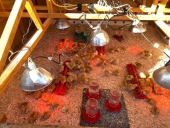
 1
1




 2
2




A build too cool to miss:Mike's GreenhouseA great example:Joseph's Garden
All the soil info you'll ever need:
Redhawk's excellent soil-building series





 2
2




A piece of land is worth as much as the person farming it.
-Le Livre du Colon, 1902




Timothy Markus wrote:
Apple cider vinegar with the live bacteria in the water is also something I've used with chickens and rabbits with excellent results.
A build too cool to miss:Mike's GreenhouseA great example:Joseph's Garden
All the soil info you'll ever need:
Redhawk's excellent soil-building series





 1
1




 2
2




A piece of land is worth as much as the person farming it.
-Le Livre du Colon, 1902












A build too cool to miss:Mike's GreenhouseA great example:Joseph's Garden
All the soil info you'll ever need:
Redhawk's excellent soil-building series













A build too cool to miss:Mike's GreenhouseA great example:Joseph's Garden
All the soil info you'll ever need:
Redhawk's excellent soil-building series














A build too cool to miss:Mike's GreenhouseA great example:Joseph's Garden
All the soil info you'll ever need:
Redhawk's excellent soil-building series









A build too cool to miss:Mike's GreenhouseA great example:Joseph's Garden
All the soil info you'll ever need:
Redhawk's excellent soil-building series





 1
1




A piece of land is worth as much as the person farming it.
-Le Livre du Colon, 1902




'Every time I learn something new, it pushes some old stuff out of my brain.'










|
I love a good mentalist. And so does this tiny ad:
permaculture and gardener gifts (stocking stuffers?)
https://permies.com/wiki/permaculture-gifts-stocking-stuffers
|

